Thoughtfully selected wall art for small spaces is one of the best ways for a compact room to appear bigger, brighter, and more stylish. Because working with a small space means every design decision matters, every element—from furniture to color choices—needs to be chosen carefully to add maximum value.
In fact, the right art, positioned correctly, can make a small room feel more open, define its personality, and create a big effect without sacrificing precious floor space. For this reason, you can make the most of your home’s limited area with the 10 wall art tricks for small rooms below.
Before You Hang: Key Principles of Wall Art in Small Spaces
Before you start hammering nails, understanding a few key principles of small space decorating can make all the difference. Choosing art isn’t just about finding something you like; it’s about finding something that harmonizes with your room’s scale, style, and color. Consequently, a strategic approach will ensure your art enhances, rather than overwhelms, your home.
Assessing Your Space: Understanding Scale and Proportion
The golden rule of art for small apartments is balance. The size of your art should be proportional to the wall and the furniture it’s near. For example, a tiny print floating on a large, empty wall can look lost, while a massive piece crammed onto a small wall can feel oppressive. Measure the wall space you intend to fill. A general interior design guideline is that art should take up roughly two-thirds of the wall space above a piece of furniture like a sofa or headboard. Understanding this relationship between the art and its surroundings is fundamental to making a small room look bigger with art.
The Color Connection: Using a Cohesive Color Palette
Your wall art should feel connected to the rest of the room. An easy way to achieve this is through a cohesive color palette. Your art doesn’t need to match everything perfectly, but it should share a common color thread. For instance, you could pull a subtle accent color from your artwork and repeat it in your throw pillows, a vase, or a rug. Alternatively, in a neutral room, your wall art can be the primary source of color, providing a vibrant focal point. This thoughtful use of color is a cornerstone of maximizing style with art.
1. Large-Scale Art Delivers Big Impact
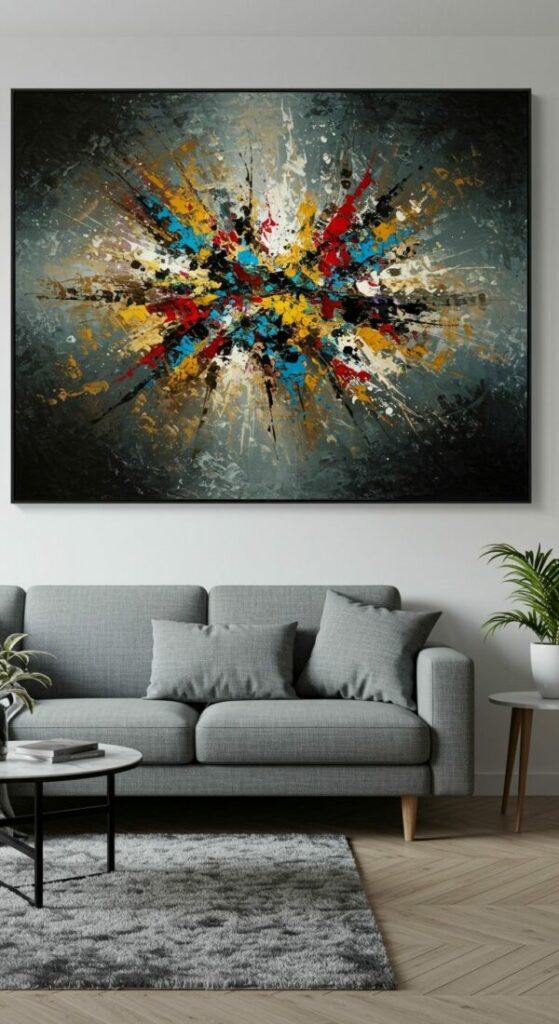
It may seem counterintuitive, but a single piece of large-scale art can make a small room feel significantly larger. This is because an oversized print or canvas creates a powerful, uncluttered focal point, tricking the eye into seeing the wall as more expansive. Compared to a collection of smaller items which can create visual clutter, one large piece simplifies the wall and gives the room a sense of grandeur and purpose.
When searching for large wall art for a small living room, look for a piece that can command attention. This could be a large abstract canvas, a high-resolution photograph, or even a textile wall hanging. The key is to hang it in a prominent position—such as over a sofa, bed, or mantel—where it can anchor the room. Ensure there is enough “breathing room” around the art so it doesn’t feel crammed from edge to edge.
To maximize the space-enhancing effect, choose a large piece with a simple, high-quality frame or a frameless gallery-wrapped canvas. An overly ornate or heavy frame can add too much visual weight and counteract the goal of making the space feel open.
2. Opt for Mirrors as Wall Art
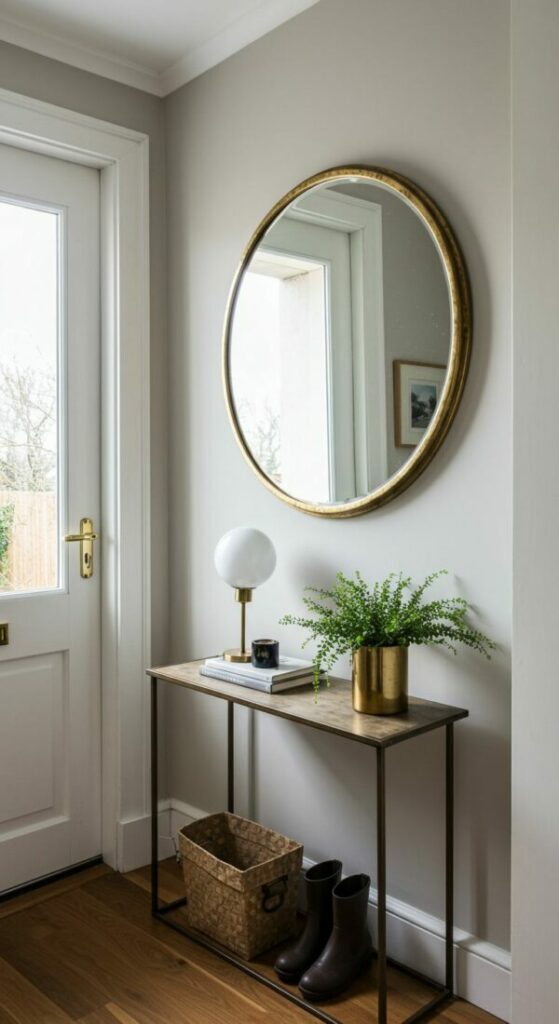
Using mirrors as wall art for small spaces is a classic interior design trick for a reason. Mirrors are more than just functional; they are masters of illusion. They reflect light—both natural and artificial—around the room, which instantly makes any space feel brighter and more open. Furthermore, they reflect the view, creating an illusion of depth that can double the perceived size of a room.
Placement is everything. To maximize brightness, hang a large mirror on the wall opposite a window. This will capture the outdoor light and bounce it back into the room. You can also use a decorative mirror as a piece of art above a console table or buffet. When it comes to shape, don’t be afraid to experiment. While a rectangular mirror is classic, using interesting geometric shapes like a round, oval, or sunburst mirror adds an artistic flair and serves as reflective wall decor.
Consider a gallery wall of small, mismatched vintage mirrors. This approach achieves the same light-reflecting benefits but with a more eclectic, bohemian feel than a single large piece.
3. Create a Cohesive Gallery Wall
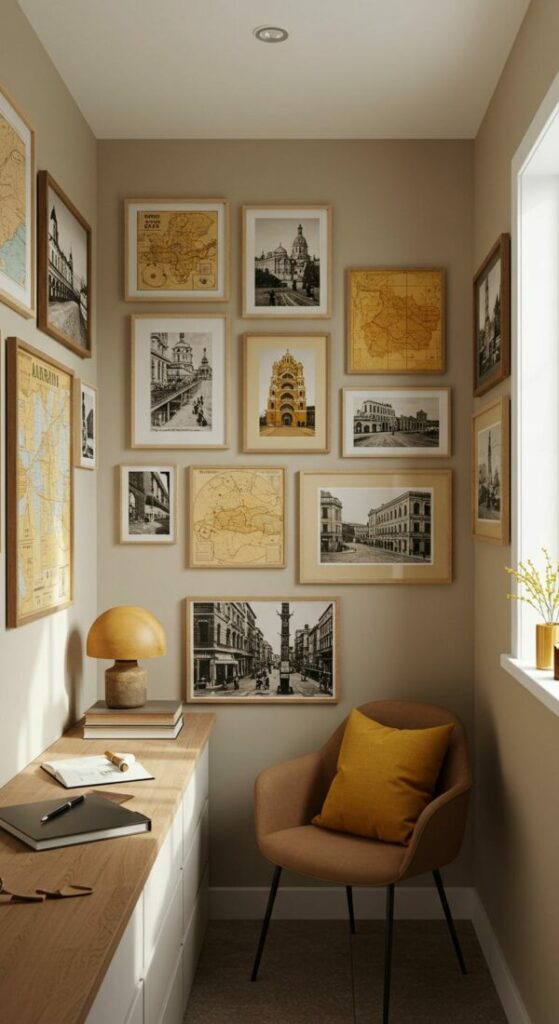
A gallery wall in a small space allows you to display multiple pieces you love without the collection feeling chaotic. By grouping smaller frames together, you create one large, cohesive focal point. This has a similar impact to a single piece of large-scale art, drawing the eye to a single area and making the wall feel decorated and intentional, rather than cluttered.
Success lies in cohesion. You can achieve this in a few ways: use frames of the same color (e.g., all black or all brass), maintain a consistent color palette within the artwork itself, or choose art from a single theme (like botanicals or travel photography). Whether you opt for a structured grid layout or a more organic, asymmetrical arrangement, a theme will hold the collection together. This is a perfect solution for art for small apartments.
Before you hang anything, trace each frame onto paper, cut them out, and tape the paper templates to the wall. This allows you to play with the arrangement and perfect your layout without making any unnecessary holes.
4. Use Vertical Art to Create a Sense of Height
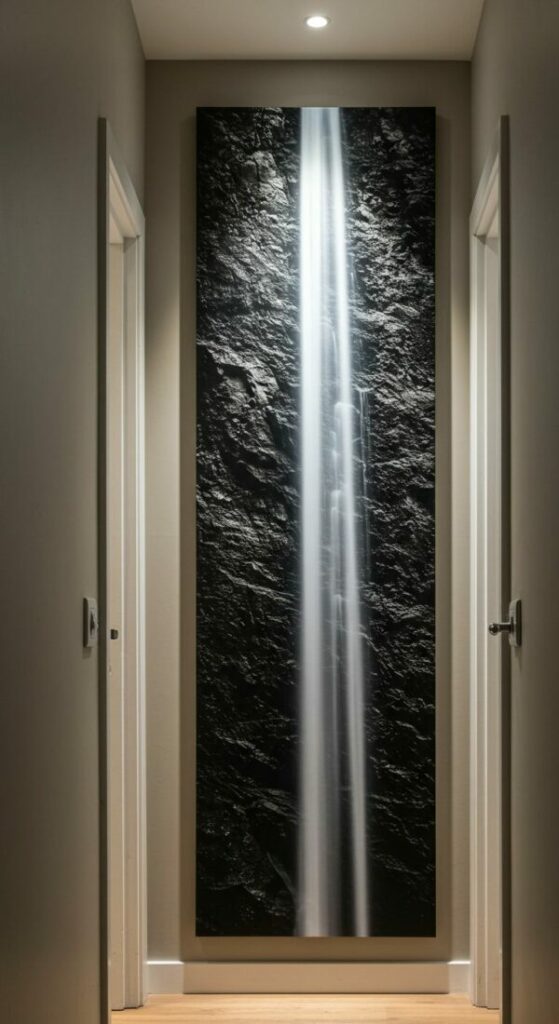
When floor space is limited, thinking vertically is essential. Vertical wall art—long, narrow pieces—naturally draws the eye upward. This vertical movement creates an illusion of height, making ceilings feel taller and the entire room feel more spacious and grand. It’s a powerful trick for rooms that feel a bit squat or cramped.
This technique is perfect for those awkward, narrow strips of wall that are often left empty, such as the space next to a doorway, in a small entryway, or between two windows. Look for tall, skinny art like vertical prints, Japanese scroll paintings, or a stack of two or three smaller, square prints hung one above the other. This is one of the most effective wall art tricks for small rooms.
To amplify the effect, hang the vertical piece slightly higher on the wall than you normally would. This will encourage viewers to lift their gaze even further, maximizing the perceived sense of height.
5. Embrace Light Colors and Minimalist Art
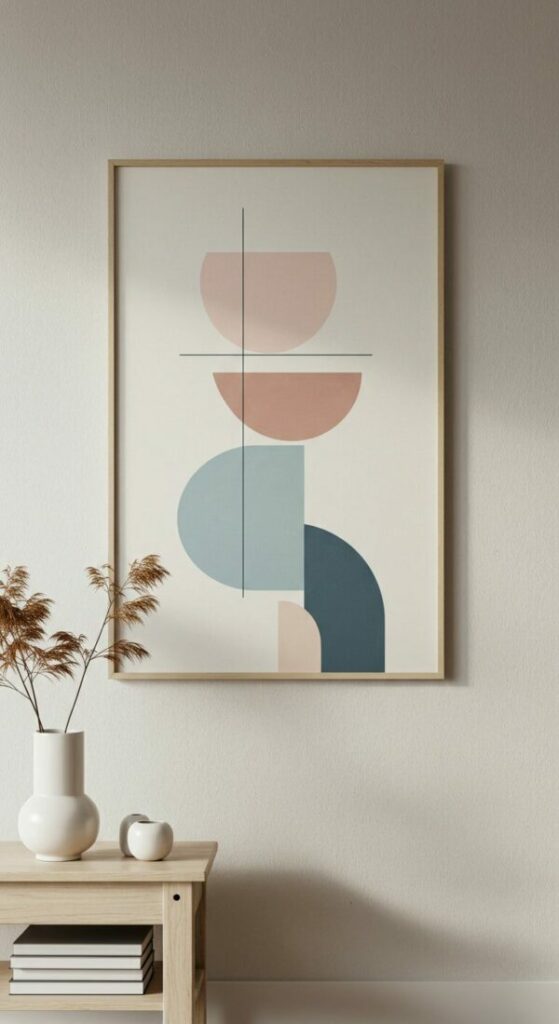
In the world of home decor, it’s well-known that light colors recede, making a space feel more airy and open. This principle applies to wall art as well. Artwork with a lot of white space or a pale color palette will feel less heavy on the wall, contributing to an overall sense of spaciousness rather than closing the room in.
Look for minimalist wall art for apartments that features soft pastels, muted tones, or a largely neutral color scheme. Artwork with simple, clean lines and uncluttered compositions, such as line drawings or simple abstract shapes, adds a touch of sophistication without visually overpowering the room. This approach to wall art for small spaces is both chic and effective.
Try a diptych or triptych (a piece of art in two or three panels) of minimalist prints. The clean separation between the panels adds to the open feel while still covering a good amount of wall space.
6. Display Art on Floating Shelves
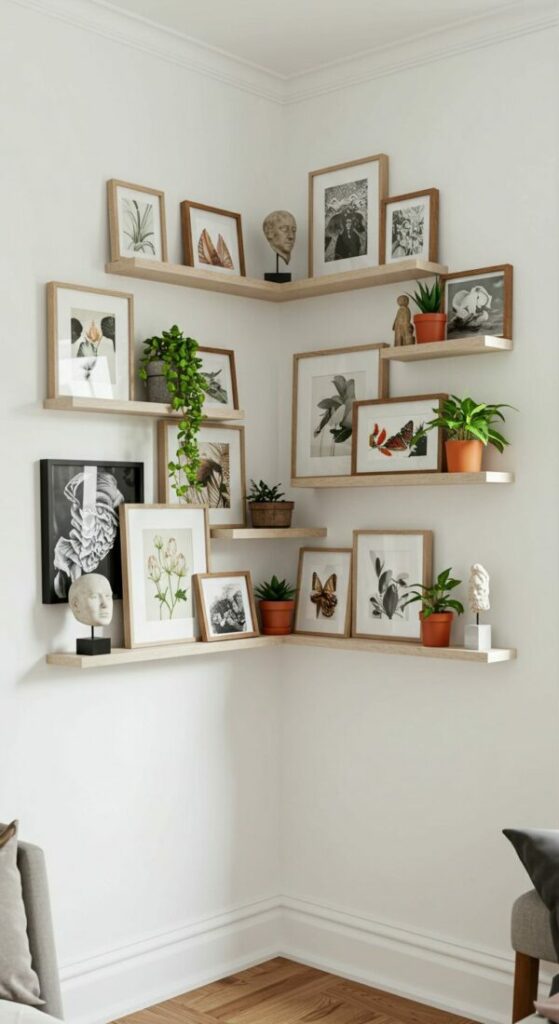
Using floating shelves for art display is an innovative way to maximize wall space without committing to a fixed, permanent arrangement. This method allows for flexibility and creates a layered, dimensional look that is far more interesting than a flat wall. It adds depth and provides a space for a rotating collection of art and objects.
Install one or more narrow picture ledges or floating shelves. Then, arrange a collection of small- to medium-sized framed art, leaning them against the wall. The magic of this approach is in the mix; you can create a beautiful vignette by layering art with other decorative items like small sculptures, potted plants, or a few beloved books. This is a perfect way to showcase your personality.
For a clean and modern look, choose floating shelves that are the same color as your wall. This will make them visually recede, giving the impression that your art and objects are floating on their own.
7. Choose Abstract or Geometric Art
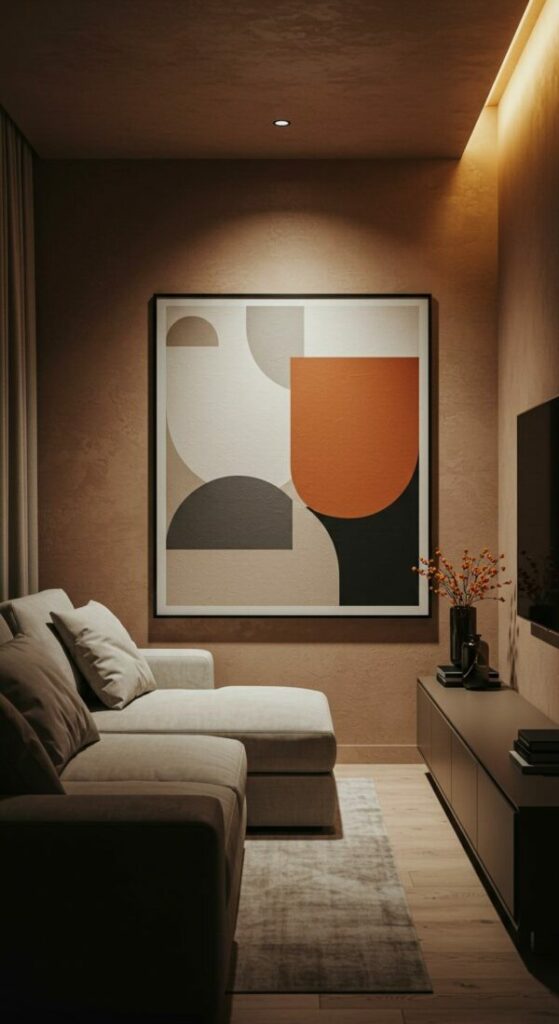
Abstract art for small rooms is an excellent choice because it adds visual interest and personality without depicting a “busy” scene. The focus on color, shape, and texture can create a mood or feeling without making the room feel cluttered with narrative details. The clean forms of geometric shapes often complement the lines of modern furniture.
Look for pieces that resonate with your home’s existing style. A bold, colorful abstract piece can be the perfect pop of energy in a neutral living room. Conversely, a large-scale abstract painting with a soft, monochromatic color palette can add texture and sophistication without overwhelming the space. This type of modern decor is incredibly versatile.
If you’re hesitant to commit to a large piece, try a set of smaller geometric prints. Hung in a simple grid, they provide a sense of order and modern style that is perfect for a small home office or dining area.
8. Select Art with Reflective Surfaces
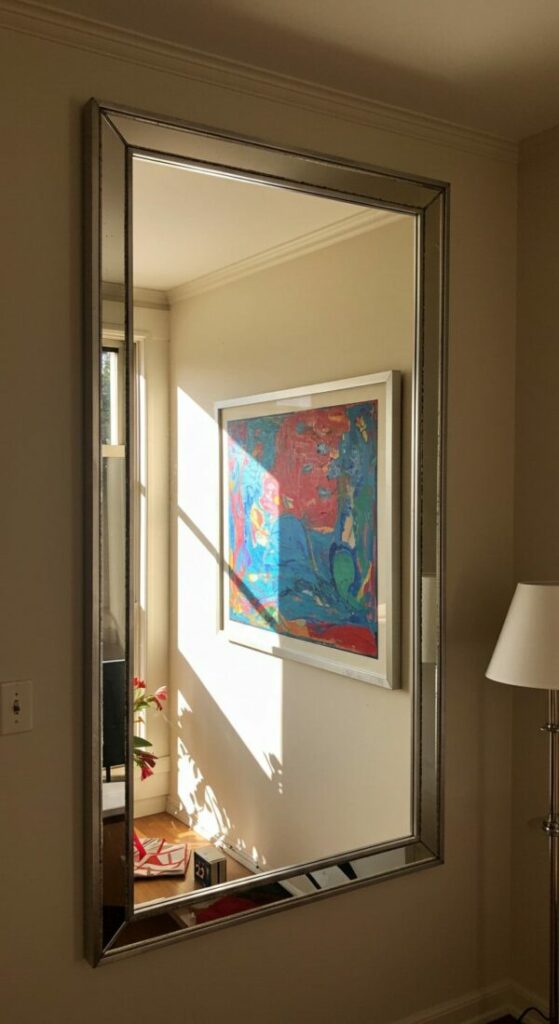
Similar to mirrors, artwork that incorporates reflective elements can help bounce light around the room, making it feel brighter and more alive. These surfaces catch the light and create subtle movement and sparkle, which adds a layer of glamour and prevents the decor from feeling flat.
The easiest way to incorporate this is through framing. Look for art with sleek metallic frames in gold, silver, or brass. You can also search for art created on metallic paper or art that incorporates gold or silver leaf. Art under glass will also have a reflective quality. These pieces of reflective wall decor will maximize the natural light in the room.
Place art with reflective surfaces where it will catch the light from a lamp or window. This will create a beautiful, dynamic effect that changes throughout the day as the light shifts.
9. Use Art to Create Zones in Open-Plan Layouts
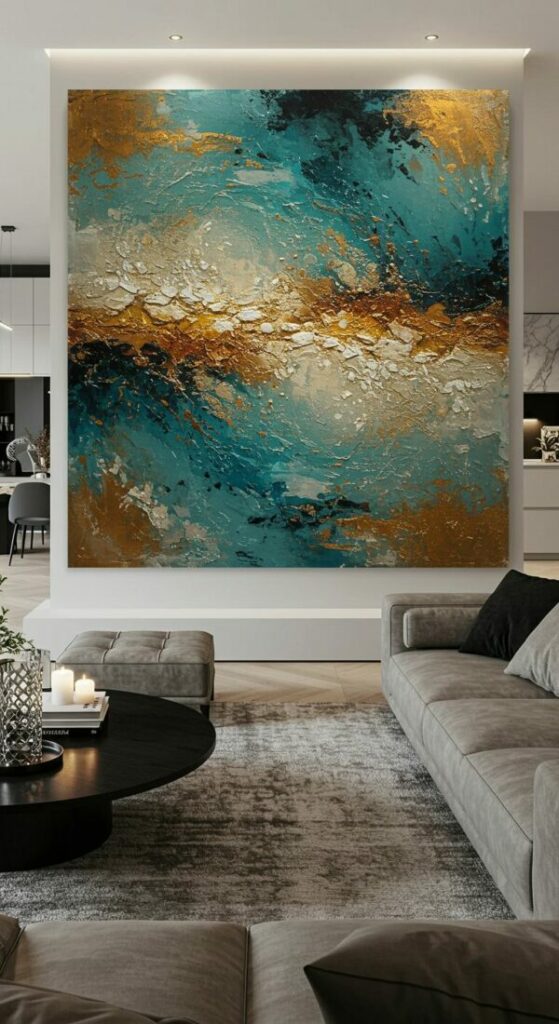
In an open-plan layout or studio apartment, art is a brilliant way to delineate different functional areas without using physical barriers like screens or bookshelves. This method helps to create zones, making a single room feel like it has multiple distinct purposes, which adds to a sense of order and spaciousness.
Hang a large piece of art or a cohesive gallery wall above the sofa to define the “living room” area. Then, use a different piece of art or a smaller gallery wall in the dining nook to define the “dining” area. Even though there are no walls, the art signals a shift in function. This is a key strategy for how to use wall art in a small space effectively.
To ensure the entire open-plan space feels connected, use artwork from a similar style or color family in each zone. This creates a cohesive flow throughout the home.
10. Choose Multi-Functional Art
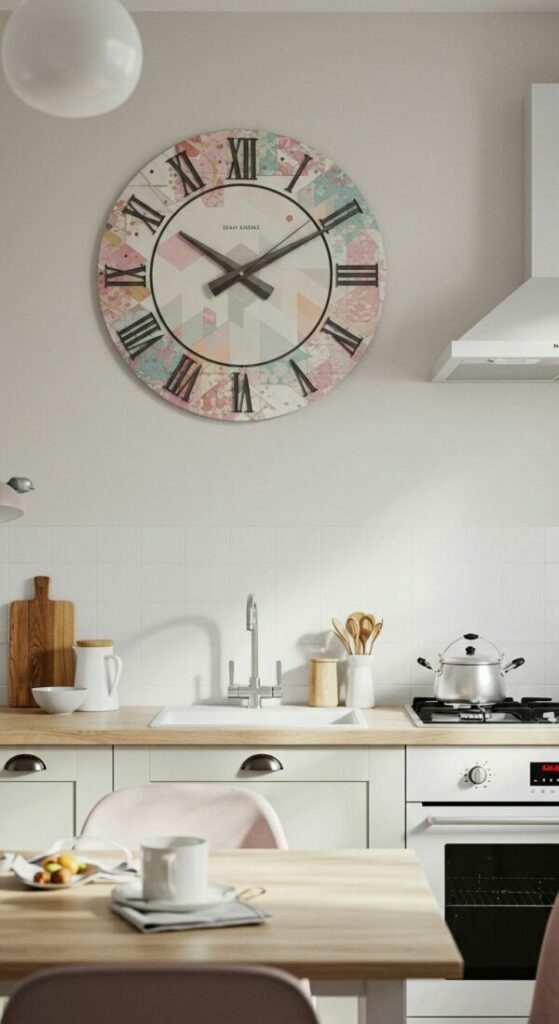
In a small space, every item should ideally serve a purpose, and art can be no exception. Multifunctional art combines aesthetics with practicality, allowing you to decorate your walls without sacrificing valuable space that could be used for storage or other functions.
Think beyond the canvas. A beautifully designed wall clock can serve as a stunning geometric art piece. A framed chalkboard or whiteboard can be a message center and a piece of rustic decor. Wall-mounted shelves with artistic brackets can display objects while also being art themselves. This approach adds utility without detracting from your style, making it one of the smartest entryway wall art ideas.
Look for wall sconces with unique, sculptural designs. When off, they look like modern wall sculptures, and when on, they provide essential ambient lighting—a perfect two-in-one solution.
Final Thoughts on Wall Art for Small Spaces
Size doesn’t have to hold you back when it comes to style and personality. As these tricks show, Thoughtful wall art choices can really make a big difference, without making the room feel cluttered. Whether you opt for a single piece of large art to create a focal point, play with vertical space to add height, or choose reflective and minimalist designs to enhance light, you can create a visually interesting environment that retains its functionality. So go ahead, use these 10 tricks to make the most of your space and turn your small home into a stylish sanctuary that truly wows!
Frequently Asked Questions
The most important rule is to hang art at the correct height: the center of the piece should be at eye level, which is typically 57-60 inches from the floor. In a small space, also consider scale. A single, large piece of art often works better than many small ones, as it creates a less cluttered, more impactful focal point.
A gallery wall can make a small room look cluttered if it’s not done cohesively. To avoid this, stick to a consistent theme, color palette, or frame style. This creates a single, unified visual statement rather than a chaotic collection of disparate items. A well-planned gallery wall can actually add depth and personality without feeling messy.
Art with light, cool colors—such as soft blues, greens, greys, and pale pastels—tends to make a room feel more open and airy. Artwork that features a lot of white or negative space is also highly effective. These pieces reflect more light and have less visual weight, contributing to a sense of spaciousness.
For most small spaces, one large piece of art is often the better choice. It creates a stronger, more confident focal point and reduces the visual clutter that can come with multiple small items. However, a tightly curated gallery wall of small pieces can also work beautifully if it’s treated as a single, cohesive unit.
